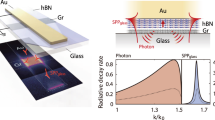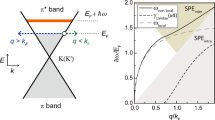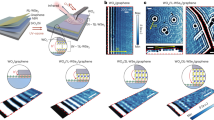Abstract
Graphene plasmons were predicted to possess simultaneous ultrastrong field confinement and very low damping, enabling new classes of devices for deep-subwavelength metamaterials, single-photon nonlinearities, extraordinarily strong light–matter interactions and nano-optoelectronic switches. Although all of these great prospects require low damping, thus far strong plasmon damping has been observed, with both impurity scattering and many-body effects in graphene proposed as possible explanations. With the advent of van der Waals heterostructures, new methods have been developed to integrate graphene with other atomically flat materials. In this Article we exploit near-field microscopy to image propagating plasmons in high-quality graphene encapsulated between two films of hexagonal boron nitride (h-BN). We determine the dispersion and plasmon damping in real space. We find unprecedentedly low plasmon damping combined with strong field confinement and confirm the high uniformity of this plasmonic medium. The main damping channels are attributed to intrinsic thermal phonons in the graphene and dielectric losses in the h-BN. The observation and in-depth understanding of low plasmon damping is the key to the development of graphene nanophotonic and nano-optoelectronic devices.
This is a preview of subscription content, access via your institution
Access options
Subscribe to this journal
Receive 12 print issues and online access
$259.00 per year
only $21.58 per issue
Buy this article
- Purchase on Springer Link
- Instant access to full article PDF
Prices may be subject to local taxes which are calculated during checkout




Similar content being viewed by others
References
Dean, C. R. et al. Boron nitride substrates for high-quality graphene electronics. Nature Nanotech. 5, 722–726 (2010).
Geim, A. K. & Grigorieva, I. V. Van der Waals heterostructures. Nature 499, 419–425 (2013).
Yankowitz, M. et al. Emergence of superlattice Dirac points in graphene on hexagonal boron nitride. Nature Phys. 8, 382–386 (2012).
Brar, V. W. et al. Hybrid surface-phonon–plasmon polariton modes in graphene/monolayer h-BN heterostructures. Nano Lett. 14, 3876–3880 (2014).
Tomadin, A., Guinea, F. & Polini, M. Generation and morphing of plasmons in graphene superlattices. Phys. Rev. B 90, 161406(R) (2014).
Poddubny, A., Iorsh, I., Belov, P. & Kivshar, Y. Hyperbolic metamaterials. Nature Photon. 7, 948–957 (2013).
Dai, S. et al. Tunable phonon polaritons in atomically thin van der Waals crystals of boron nitride. Science 343, 1125–1129 (2014).
Caldwell, J. D. et al. Sub-diffractional volume-confined polaritons in the natural hyperbolic material hexagonal boron nitride. Nature Commun. 5, 5221 (2014).
Jablan, M., Buljan, H. & Soljačić, M. Plasmonics in graphene at infrared frequencies. Phys. Rev. B 80, 245435 (2009).
Ju, L. et al. Graphene plasmonics for tunable terahertz metamaterials. Nature Nanotech. 6, 630–634 (2011).
Nikitin, A. Y., Guinea, F., García-Vidal, F. J. & Martín-Moreno, L. Edge and waveguide terahertz surface plasmon modes in graphene microribbons. Phys. Rev. B 84, 161407(R) (2011).
Koppens, F. H. L., Chang, D. E. & García de Abajo, F. J. Graphene plasmonics: A platform for strong light-matter interactions. Nano Lett. 11, 3370–3377 (2011).
Grigorenko, A. N., Polini, M. & Novoselov, K. S. Graphene plasmonics. Nature Photon. 6, 749–758 (2012).
Yan, H. et al. Tunable infrared plasmonic devices using graphene/insulator stacks. Nature Nanotech. 7, 330–334 (2012).
Yan, H. et al. Damping pathways of mid-infrared plasmons in graphene nanostructures. Nature Photon. 7, 394–399 (2013).
Brar, V. W., Jang, M. S., Sherrott, M., Lopez, J. J. & Atwater, H. A. Highly confined tunable mid-infrared plasmonics in graphene nanoresonators. Nano Lett. 13, 2541–2547 (2013).
Jang, M. S. et al. Tunable large resonant absorption in a midinfrared graphene Salisbury screen. Phys. Rev. B 90, 165409 (2014).
Tassin, P., Koschny, T. & Soukoulis, C. M. Graphene for terahertz applications. Science 341, 620–621 (2013).
Low, T. & Avouris, P. Graphene plasmonics for terahertz to mid-infrared applications. ACS Nano 8, 1086–1101 (2014).
García de Abajo, F. J. Graphene plasmonics: Challenges and opportunities. ACS Photonics 1, 135–152 (2014).
Fang, Z. et al. Active tunable absorption enhancement with graphene nanodisk arrays. Nano Lett. 14, 299–304 (2014).
Wang, L. et al. One-dimensional electrical contact to a two-dimensional material. Science 342, 614–617 (2013).
Fei, Z. et al. Gate-tuning of graphene plasmons revealed by infrared nano-imaging. Nature 487, 82–85 (2012).
Chen, J. et al. Optical nano-imaging of gate-tunable graphene plasmons. Nature 487, 77–81 (2012).
Keilmann, F. & Hillenbrand, R. Near-field microscopy by elastic light scattering from a tip. Phil. Trans. R. Soc. Lond. A 362, 787–805 (2004).
Ocelic, N., Huber, A. & Hillenbrand, R. Pseudoheterodyne detection for background-free near-field spectroscopy. Appl. Phys. Lett. 89, 101124 (2006).
Chen, J. et al. Strong plasmon reflection at nanometer-size gaps in monolayer graphene on SiC. Nano Lett. 13, 6210–6215 (2013).
Fei, Z. et al. Electronic and plasmonic phenomena at graphene grain boundaries. Nature Nanotech. 8, 821–825 (2013).
Schnell, M., Carney, P. S. & Hillenbrand, R. Synthetic optical holography for rapid nanoimaging. Nature Commun. 5, 3499 (2014).
Alonso-González, P. et al. Controlling graphene plasmons with resonant metal antennas and spatial conductivity patterns. Science 344, 1369–1373 (2014).
Gerber, J. A., Berweger, S., O’Callahan, B. T. & Raschke, M. B. Phase-resolved surface pasmon interferometry of graphene. Phys. Rev. Lett. 113, 055502 (2014).
Principi, A. et al. Plasmon losses due to electron–phonon scattering: The case of graphene encapsulated in hexagonal boron nitride. Phys. Rev. B 90, 165408 (2014).
Fei, Z. et al. Infrared nanoscopy of dirac plasmons at the graphene–SiO2 interface. Nano Lett. 11, 4701–4705 (2011).
Xue, J. et al. Scanning tunnelling microscopy and spectroscopy of ultra-flat graphene on hexagonal boron nitride. Nature Mater. 10, 282–285 (2011).
Zhang, L., Fu, X. & Yang, J. Excitation of propagating plasmons in semi-infinite graphene layer by free space photons. Commun. Theory Phys. 61, 751–754 (2014).
Johnson, P. & Christy, R. Optical constants of the noble metals. Phys. Rev. B 6, 4370–4379 (1972).
Principi, A., Vignale, G., Carrega, M. & Polini, M. Impact of disorder on Dirac plasmon losses. Phys. Rev. B 88, 121405(R) (2013).
Principi, A., Vignale, G., Carrega, M. & Polini, M. Intrinsic lifetime of Dirac plasmons in graphene. Phys. Rev. B 88, 195405 (2013).
Li, Z. Q. et al. Dirac charge dynamics in graphene by infrared spectroscopy. Nature Phys. 4, 532–535 (2008).
Mak, K. F. et al. Measurement of the optical conductivity of graphene. Phys. Rev. Lett. 101, 196405 (2008).
Christensen, J., Manjavacas, A., Thongrattanasiri, S., Koppens, F. H. L. & García de Abajo, F. J. Graphene plasmon waveguiding and hybridization in individual and paired nanoribbons. ACS Nano 6, 431–440 (2012).
Vakil, A. & Engheta, N. Transformation optics using graphene. Science 332, 1291–1294 (2011).
Li, Y. et al. Graphene plasmon enhanced vibrational sensing of surface-adsorbed layers. Nano Lett. 14, 1573–1577 (2014).
Nikitin, A. Y., Guinea, F., Garcia-Vidal, F. J. & Martin-Moreno, L. Surface plasmon enhanced absorption and suppressed transmission in periodic arrays of graphene ribbons. Phys. Rev. B 85, 081405(R) (2012).
Thongrattanasiri, S., Koppens, F. H. L. & García de Abajo, F. J. Complete optical absorption in periodically patterned graphene. Phys. Rev. Lett. 108, 047401 (2012).
Gullans, M., Chang, D., Koppens, F. H. L., García de Abajo, F. J. & Lukin, M. Single-photon nonlinear optics with graphene plasmons. Phys. Rev. Lett. 111, 247401 (2013).
Huidobro, P. A., Nikitin, A. Y., González-Ballestero, C., Martín-Moreno, L. & García-Vidal, F. J. Superradiance mediated by graphene surface plasmons. Phys. Rev. B 85, 155438 (2012).
Wunsch, B., Stauber, T., Sols, F. & Guinea, F. Dynamical polarization of graphene at finite doping. New J. Phys. 8, 318 (2006).
Hwang, E. H. & Das Sarma, S. Dielectric function, screening, and plasmons in two-dimensional graphene. Phys. Rev. B 75, 205418 (2007).
Principi, A., Polini, M. & Vignale, G. Linear response of doped graphene sheets to vector potentials. Phys. Rev. B 80, 075418 (2009).
Cai, Y., Zhang, L., Zeng, Q., Cheng, L. & Xu, Y. Infrared reflectance spectrum of BN calculated from first principles. Solid State Commun. 141, 262–266 (2007).
Acknowledgements
It is a great pleasure to thank J. D. Caldwell, J. García de Abajo, A. Tomadin and L. Levitov for many useful discussions. This work used open source software (www.matplotlib.org, www.python.org). F.H.L.K. acknowledges support by the Fundacio Cellex Barcelona, the ERC Career integration grant 294056 (GRANOP), the ERC starting grant 307806 (CarbonLight), and support by EU project GRASP (FP7-ICT-2013-613024-GRASP). F.H.L.K., M.P. and R.H. acknowledge support by the EU under Graphene Flagship (contract no. CNECT-ICT-604391). A.P. and G.V. acknowledge DOE grant DE-FG02-05ER46203 and a Research Board Grant at the University of Missouri. M.P. and M.C. acknowledge support by the Italian Ministry of Education, Universities and Research (MIUR) through the programme ‘FIRB – Futuro in Ricerca’, Project PLASMOGRAPH (Grant No. RBFR10M5BT) and Project HybridNanoDev (Grant No. RBFR1236VV). M.P. also acknowledges support by the MIUR through the programme ‘Progetti Premiali 2012’ – Project ABNANOTECH. R.H. acknowledges support by the ERC starting grant 258461 (TERATOMO) and the Spanish Ministry of Economy and Competitiveness (National Project MAT2012-36580). Y.G. and J.H. acknowledge support from the US Office of Naval Research N00014-13-1-0662.
Author information
Authors and Affiliations
Contributions
A.W. and M.B.L. performed the experiments, discussed the results and wrote the manuscript. Y.G. fabricated the samples. A.P., M.P., G.V. and M.C. provided the theory on different loss mechanisms. P.A-G. helped with measurements. K.W. and T.T. synthesized the h-BN samples. G.V., M.P., J.H., R.H. and F.H.L.K. supervised the work, discussed the results and co-wrote the manuscript. All authors contributed to the scientific discussion and manuscript revisions.
Corresponding author
Ethics declarations
Competing interests
R.H. is co-founder of Neaspec GmbH, a company producing scattering-type scanning near-field optical microscope systems such as the ones used in this study. All other authors declare no competing financial interests.
Supplementary information
Supplementary Information
Supplementary Information (PDF 1045 kb)
Rights and permissions
About this article
Cite this article
Woessner, A., Lundeberg, M., Gao, Y. et al. Highly confined low-loss plasmons in graphene–boron nitride heterostructures. Nature Mater 14, 421–425 (2015). https://doi.org/10.1038/nmat4169
Received:
Accepted:
Published:
Issue Date:
DOI: https://doi.org/10.1038/nmat4169
This article is cited by
-
Manipulating hyperbolic transient plasmons in a layered semiconductor
Nature Communications (2024)
-
Compensating losses in polariton propagation with synthesized complex frequency excitation
Nature Materials (2024)
-
Curved anisotropic polaritons
Frontiers of Physics (2024)
-
Ambipolar charge-transfer graphene plasmonic cavities
Nature Materials (2023)
-
Hyperbolic polaritonic crystals with configurable low-symmetry Bloch modes
Nature Communications (2023)



